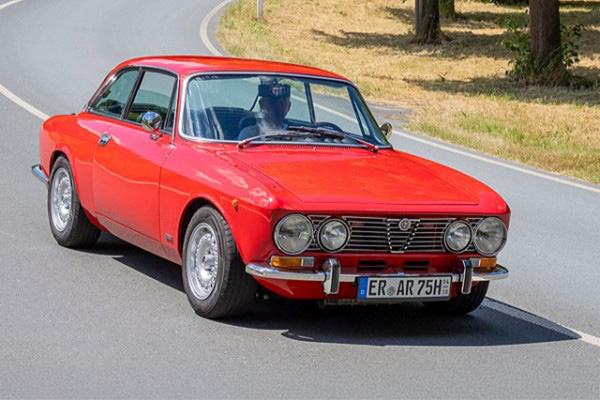Interview with The Classic Valuer: Why it’s now a great time to buy a classic car, rather than to sell
Giles Gunning and Charlie Waller started The Classic Valuer – a website that provides values for classic cars, hypercars and supercars based on auction results going back as far as the 1980s.
It is a valuable tool for classic car buyers who simply want to know a fair price to pay for a car at auction or simply buying a car from a trader or private seller. The data The Classic Valuer publishes for its audience is rich with values for 13,000 individual models, stretching from 2025 hypercars and supercars all the way down to vintage vehicles from the 1880s. It takes results from 45 auction houses around the world and has half a million sold car listings on the platform.
Giles and Charlie started the platform after Giles attended an auction nine years ago with the intention of buying a Jaguar. The price was out of his league but at that auction he secured an Alfa Romeo 1600 GT Junior. His experience, however, begged an inevitable question about what a fair price should be. And, as he told us: “I just simply didn’t know how much to pay and whether it was going to burn a hole in my pocket, so that started the idea for The Classic Valuer and we took it from there. Now, we are five years in and the data we have collected helps hundreds of thousands of people around the world each year people get a clearer idea of what they should be buying or selling a car for.”

The classic car market has changed radically over the last five years. The proliferation of online auction houses and the amount of information that is now publicly available has changed the game, giving more power to buyers. But how has that transformed the market and what does it mean for those thinking of buying a classic car or a collection of classic cars?
“Historically, dealers have worked off the premise of them having superior information to the market, particularly if they have a particular niche. They understand the market for that car, what’s desirable, what's not desirable and what the prices should be for that particular car, or collection of cars.
“The democratisation of information, whether it be through values through a site like ours, or on forums means the buyer can make much more informed decisions and have near-information parity with a dealer.
“The quality of information is far better now. That strength the dealer used to have has been diminished. People can see what cars have been transacted for over the years because that information is publicly available now. So much of that information is in the hands of buyers and it leads to the question of how some dealers can justify the premium they are charging above what a car would sell for publicly.
“It’s tough to be a dealer and or an auction house now. There’s more competition than ever and they are going after a finite pool of potential vehicles to sell. You’ve got more auctions and more auction houses and as a result there’s more opportunities to get real bargains, particularly when you layer in what’s happened to prices for many vehicles in recent years.”
So, it feels like a buyer’s market right now, particularly with values softening over the past two or three years. Does that mean more people are collecting cars?
“There is a growing trend in the auction world when sellers are offloading collections en masse,” Giles explained. “They will wrap them under a banner and sell it as a collection. So instead of saying here’s 15 cars ready for sale individually, they might call it ‘The Gunning Collection’ for example, and frame it that way.
“So, let’s say a seller has 15 to 20 cars: they want out, so they give the whole lot to an auction to sell rather than sell each individually through another channel. It makes more sense to do it that way. In recent years, a collector in Kuwait who had a stack of Aston Martins, mostly DB6s, has been drip feeding back into the market. There was a similar situation with a collection of McLaren SLRs in the Middle East and they are now slowly filtering back into the market too.”
According to Giles classic car auction activity this year has been frenetic with the number of auctions up by almost 200% from January to June, against the same period in 2020.
“It is fair to say the number of online auction houses has increased massively,” added Giles. “Collecting Cars started the trend this side of the pond – five years ago this wasn’t really a thing. Now there’s all manner of sites you can go to. Online auctions make up 20% of the volume that we see transacted, but if you included the USA online auction house, Bring a Trailer, that number is much higher.”
But has the number of cars up for sale increased?
“Auction houses are under a lot of pressure to increase profits, and one way is simply to increase the number of auctions they hold in the year,” said Giles. “We see this regularly with auction houses expanding into new territories such as Broad Arrow expanding into Europe in the past 12 months.
“It’s easier than ever to sell your car as well. Fourteen days from having the first conversation with an online auction house, you could have your car sold and money in your bank account. And auctions are not always selling cars people are looking to sell. They might call someone they know has a particular car and explain that the market is really strong for that right now and people might well be minded to sell. As a result the number of cars being offered for sale has increased massively.
“Classic cars are a completely discretionary purchase. You don’t need to buy an 80s BMW: you buy it because you love it. You don’t need a pre-war Bentley or an Austin 7. The thing is there are plenty of cars to choose from. Supply is high: there’s just too many cars on the market and that has softened values. Put simply, it is a good time to buy, not a great time to sell.”

COMMENT